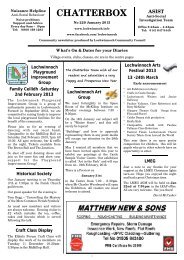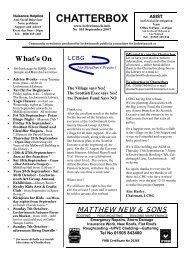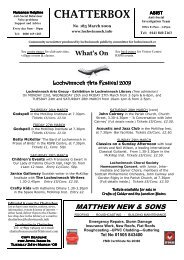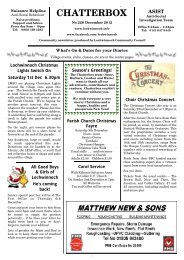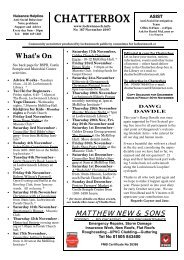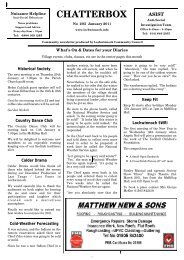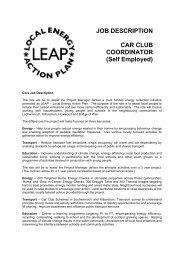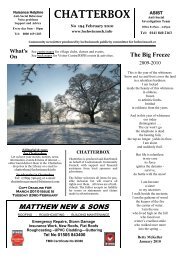april-13 - Lochwinnoch Online
april-13 - Lochwinnoch Online
april-13 - Lochwinnoch Online
- No tags were found...
You also want an ePaper? Increase the reach of your titles
YUMPU automatically turns print PDFs into web optimized ePapers that Google loves.
Limestone Quarries AreMiners' MemorialsDuring the 18th and 19th centuries,ghostly figures clad in dirty-whitegarments were often encountered atdead of night in woods and countrylanes around <strong>Lochwinnoch</strong>.The eerie apparitions were sometimesaccompanied by cart-pulling phantomhorses wending their way along theCastle Semple lochside or through treesat Woodside meadows, Barr Castle andthe Calder Glen. They flickeredfearsomely and glowed grotesquely inthe gloom like disembodied spirits oflong-dead slain soldiers, murder victims,heralds from hell, grim omens of deathand countryfolk who'd died in sadcircumstances.Terrified on-lookers didn't realise thewhitened men, horses and woodenwagons were loading lime from quarriesfor mortar to build cottages, farms,castles, mansions, cathedrals and walls.This was at the beginning of theIndustrial Revolution with theirburgeoning factories and theintroduction of Land Enclosures Actswhich meant fields were to be enclosedand roads and dwellings for workersbuilt.Lime is white in colour and its powderwas what gave workers in the industryand their horses and carts theirfrightening nocturnal luminousappearance.The lime was also used to fertilise andincrease the productivity of fields wherepotatoes, turnips, wheat and barley weregrown to feed an ever-expandingworkforce in cotton mills, flax factoriesand engineering foundries springing upall over the country, especially inRenfrewshire which was a hotbed ofindustrial activity.But lime was a lethal cargo. Its causticpowder, also used as quicklime to burnbodies of executed criminals, coveredfrom head to foot the courageous cartersand horses who worked so closely withthe corrosive chemical.So thousands of lime workers went toearly graves after breathing in its deadlydust or absorbing it through their skin.The process began when limestone wasquarried with gunpowder, picks, shovelsand axes.Following its excavation, the rock wasthen set alight in large stone or earthkilns along with coal.This was to erode the stone and whittleit down into the fine powder whichbecame such an important cog in thewheel in Renfrewshire's development asan industrial county.Although some of these kilns, like onedating from the late 18th century atMidtown Wood near Howwood in<strong>Lochwinnoch</strong> parish, were magnificentstone-arched structures, others weresimply depressions in the groundwhere the lime and coal were left toburn for a few days until the powderwas extracted.Paisley academic Dr Stuart Nisbet hasidentified and provided mapreferences for several areas around<strong>Lochwinnoch</strong> where limestone washewn between the 1780s and 1880swhen the industry was at its height. Iam indebted to Dr Nisbet for makingthe results of his research availableand pioneering a previously littleknownfield of study which wasdeservedly rewarded with his doctoratefrom the former University of Paisley.One of the most prolific sites locallywas at the aptly-named Limekilnsplantation (NS341589), near theformer St Joseph’s nursing home onGlenlora road.Although kilns are no longer inevidence at this location, traces of 18thcentury quarries still remain amongthe trees. As always, these must beapproached with extreme care becausedisused industrial sites can beminefields of crumbling masonry, deepholes, dilapidated machinery and,quite literally, other pitfalls.Evidence of lime kilns and quarries hasalso been uncovered at Netherhouses(NS355570) on the south side of BarrLoch; Risk (NS378597) on the mainHowwood to <strong>Lochwinnoch</strong> road; andPark (NS378597), near Roebank Glen,which is shown on an 1820 canal mapas having an extensive "great limework."The Risk lime quarry is shown on thatsame canal map. I remember manyyears ago seeing metal wagon linesnear the entrance to Lochside Housewhich were probably used fortransporting lime across the fields to<strong>Lochwinnoch</strong>, possibly for rail or canal8transport.There were at least two sites at CastleSemple estate (NS371596 ANDNS372594) dating from around 1720.Although no longer visible following theconstruction of the Macdowall drainagecanal along the south shore of CastleSemple Loch, as well as the mainGlasgow to Ayrshire railway line, therewas still evidence of excavated spoilheaps when I last visited the site.Kerse (NS3356) on the <strong>Lochwinnoch</strong> toKilbirnie road was the site of a large coaland lime work drained by both waterandsteam-powered engines.The quarries in the <strong>Lochwinnoch</strong> areawere owned mainly by wealthy landownerslike the Macdowalls of CastleSemple House and the Houstouns ofJohnstone Castle who invested heavilyin their mineral wealth and addedconsiderably to their vast fortunes.But we must never forget the bravequarriers and hewers of the limestonewhose toil laid the foundation of thelairds' and nation's opulence. Their"ghosts" may no longer wander thecountryside around <strong>Lochwinnoch</strong> wherethey worked in such dangerousenvironments. But their spirit lives on.The disused quarries which were thescenes of their earthly labour are theirshrines.And markings from spades, shovels andpicks still visible on the rocks are theireternal epitaphs.Derek ParkerDerek Parker worked as a countrysideranger at Clyde Muirshiel RegionalPark from 1985 to 1999Food ShockRenfrewshire Council apologises forthe traces of beef found in minceserved at ROAR lunches.A spokesman said “We simply don’tknow how the beef got in there but weare investigating and hope to haveanswers soon.”



